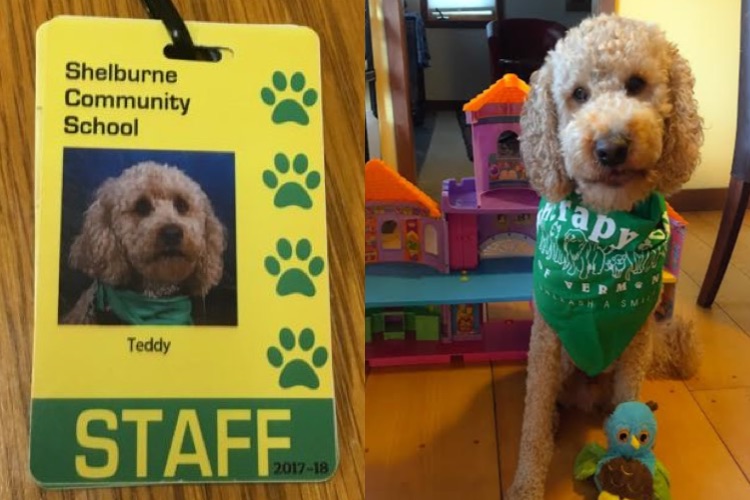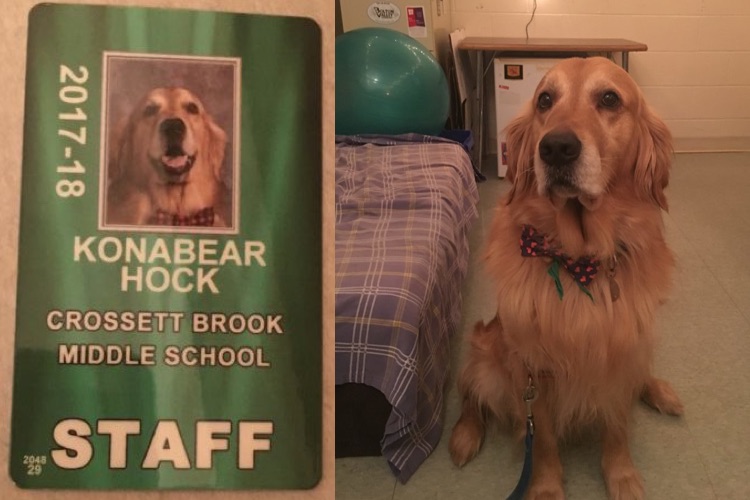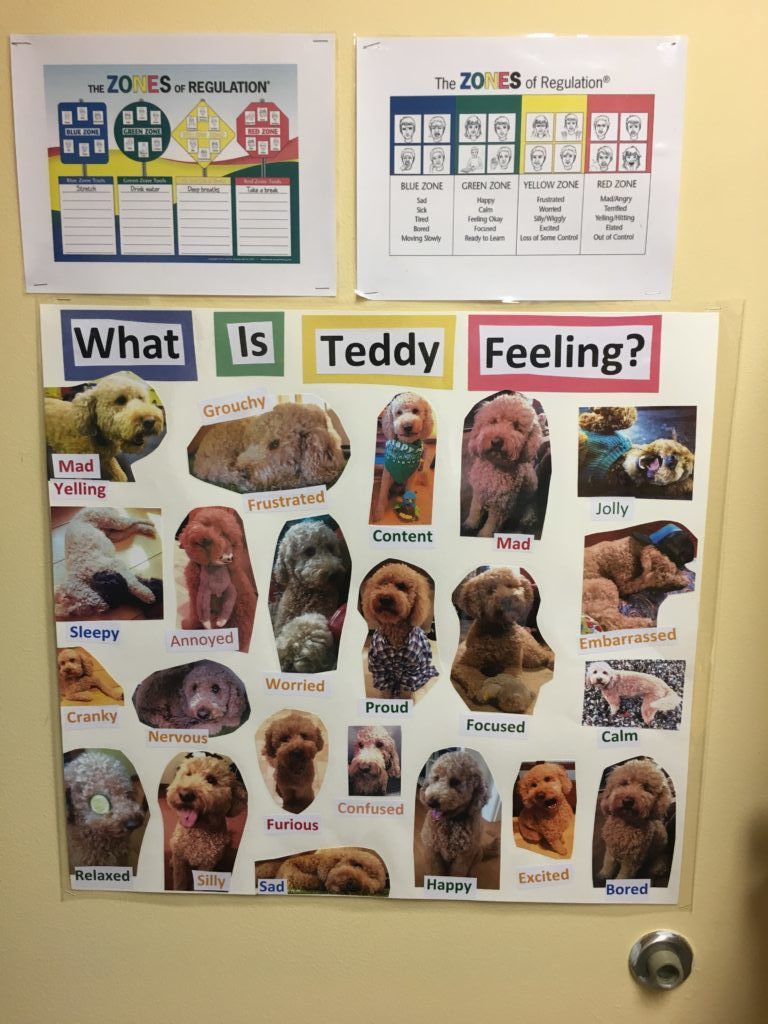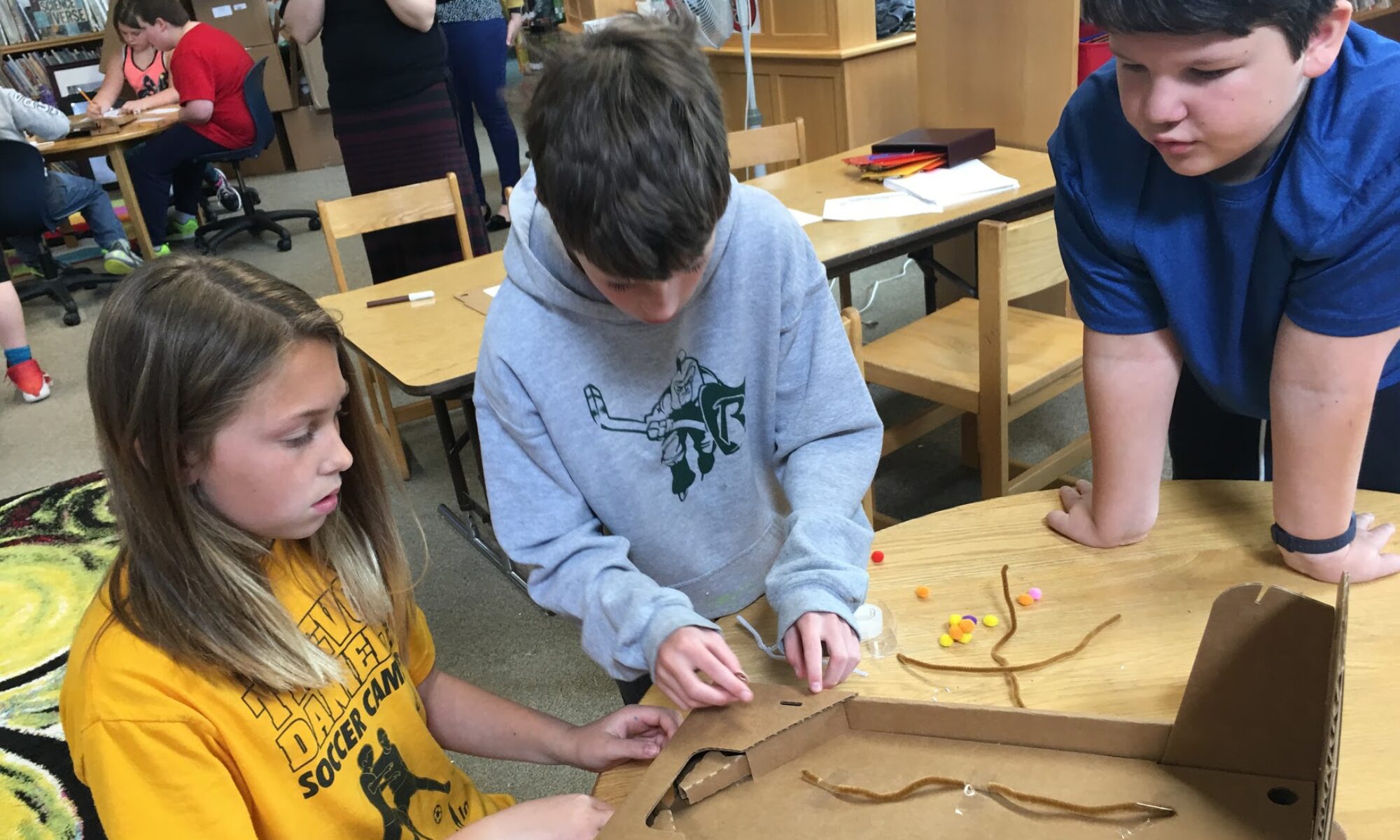Who let the dogs in?
 For some students, being ready to learn when they arrive at school is a big ask, and more than a few carry trauma or mental health burdens through their day. And that’s why more and more, schools in Vermont are adding therapy dogs to their staffing rosters.
For some students, being ready to learn when they arrive at school is a big ask, and more than a few carry trauma or mental health burdens through their day. And that’s why more and more, schools in Vermont are adding therapy dogs to their staffing rosters.
And they’re seeing some pretty pawsitive benefits to the arrangement.
Meet Teddy and Kona

Students and staff at Shelburne Community School have the pleasure of seeing and working with Teddy, a five-year-old Australian Labradoodle, and his human, Laurel.
It’s important to know that Labradoodles have hair (not fur) and are less likely to cause a problem with allergies. Who knew?

Similarly, the Crossett Brook Middle School community has Kona, a bow-tie wearing, soon-to-be eight-year-old Golden Retriever, and his human, Britta. (The bow-tie is a nod to Crossett Brook’s principal, Tom Drake, who wears a bow-tie as part of his daily school attire.)
Both these dogs and and their humans have been through a rigorous training and certification program through Therapy Dogs of Vermont.
What are the pawsitive benefits?
Did you know that petting an animal is good for our mental health? It can release oxytocin, that's the hormone that helps us feel closer to each other, in addition to lowering cortisol, the stress hormone, helping us feel less anxious. #stressmanagement pic.twitter.com/96dBBQb5F1
— ThisIsVT (@ThisIsVT) March 26, 2018
To help highlight this work Shelburne Community School sent an information flyer home to families and students. The positive benefits listed include:
- Stress management
- Developing empathy
- Strength and emotional regulation
- Decreasing anxiety
- Increased sense of responsibility
- Achieving and maintaining mood stability
- Building social skills and perspective
- Gaining the ability to recognize and talk about feelings.

In both schools Positive Behavioral Interventions and Support (PBIS) help students recognize their Zone Of Regulation. Here students can identify a feeling or emotion by checking out Teddy’s poster. The goal is to spend more time in the green zone!
What do students think about therapy dogs?
“The best part of my day is working with Teddy. He gets paid in cheese.”
How do therapy dogs know its time for work?
It’s worth mentioning that these dogs live with their human handlers and outside of work they are regular dogs that like to run, play, role in the mud, and chase tennis balls. One handler described her dog as a “wild, silly, goose” when not at work.
But both dogs have similar routines and schedules.
Like many of the us their day starts with getting ready for work. The green bandana is a key signal that work mode has begun. Teddy also has a work-specific leash and when he see’s that he know what’s up.
What’s a typical day like for Teddy and Kona?
Arriving at school, both Teddy and Kona are highly visible. Usually walking around the school checking in classrooms to see how everyone is doing.

If anyone needs support, a morning walk-around is one option.
“Sometimes it easier to ask for help from an animal than an adult.”
Many days begin with requests for the dogs to be part of morning meeting. I can’t think of a better way to start my morning. In the beginning of the year this is a great way to meet the dogs and learn about their work but also how to interact with them.
Not all students and adults are comfortable around dog. Participation is by choice and the handlers will always ask if you want to meet the dog first.
Some students do say no thank you and that’s okay. Although, over time, many choose to interacting with the dog is some way.
The middle part of the day is a combination of:
- office hours;
- meeting with individual students;
- being part of a class;
- attending team and faculty meetings if needed.
The dogs also need body breaks during the day. Sometime students get to take the dogs for a walk. Some have specific jobs like making sure that water bowls are full.
From my observations the dogs are extremely busy which is why they are only in the building three-ish days a week. This is very physically and emotional demanding work for the dogs and they need rest to be at their best.
What skills do they support?
Both dogs support social skills, work, friendship, modeling of behaviors, and responsibility (to name a few).
If students are having trouble walking safely in the building Teddy or Kona and can be used to model the appropriate behavior. “Can you show Teddy or Kona how to walk down the hallway correctly?”
For students who are reluctant to walk into the building? The dogs and can provide a feeling of safety and belonging.
Similarly, “Teddy and Kona have sensitive ears, can you show them how you can talk in a calm voice.” For some students that get to work with the dogs one-on-one they have a greater expertise and familiarity and when the dogs come into class they can be an experts with their peers.
Dogs are magic, y’all
One story that particularly touched at my heart strings and speaks to the power of these animals was when a student showed up in Kona’s space visible upset and crying uncontrollably. The student curled up on Kona’s bed and continued to cry. Without hesitation Kona sat next to the student and started to nuzzle his nose into the situation. Then began licking away the tears and eventually the student gave Kona a big hug and was able to return to class. The dogs have an incredible gift.
How did we end up with these therapy dog teams?
Teddy and Laurel’s relationship started when Teddy was a puppy. “My intent was to always have him be a therapy dog.” Teddy is from a breeder that has produced many dogs with the right temperament for therapy work. For the first two years Teddy was exposed to many different social situations. Places where we could get used to loud noises and people petting him like concerts and colleges campuses. Really it was training for attachment and trust work. He also attended doggie obedience school in Williston. Then his specific work began with Therapy Dogs of Vermont to complete the certification process. They offer practice tests, clinics, and specific support with skills the dogs need to pass the test.
It takes teamwork
Seems like it’s a fair assessment that the humans (Laurel and Britta) often take a backseat to the excitement and joy of spending time with the dogs. However, the hard work these folks have put it should not go unmentioned. Their vision, passion, and dedication to supporting students and staff is worthy of their own blogpost. These folks are making significant impact within the culture and climate of the school. As well as supporting everyone in the school. Also a “thank you” does not seem enough to validate this inspiring work, but THANK YOU!
What do therapy dogs have to do with innovative school change?
Empowering schools to support engaged, whole learners involves a variety of strategies, with learners having the ability to choose which ones suit themselves, their experience and their current mood. And therapy dogs can be part of providing support to those whole, engaged learners, when, if and how they need it.


It was really training for attachment and trust work. He also attended doggie obedience school in Williston. The hard work these folks have put it should not go unmentioned. Their vision, passion, and dedication to supporting students and staff is worthy of their own blogpost.
Thank you for providing this needed context on these dogs’ training and journey to school work. We would love to hear more about the connection between Williston’s canine obedience trainers and school support. Could I ask you to tell us more at audrey@tarrantinstitute.org?
Thanks again for the follow-up. We appreciate you reading!